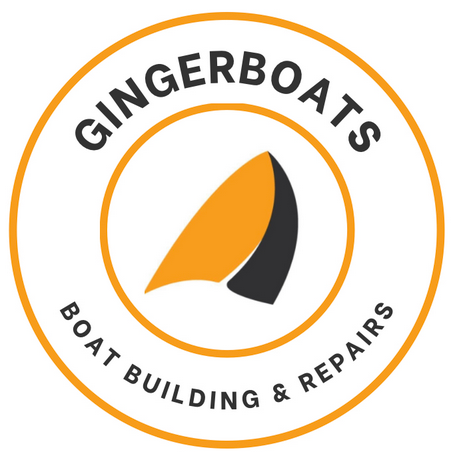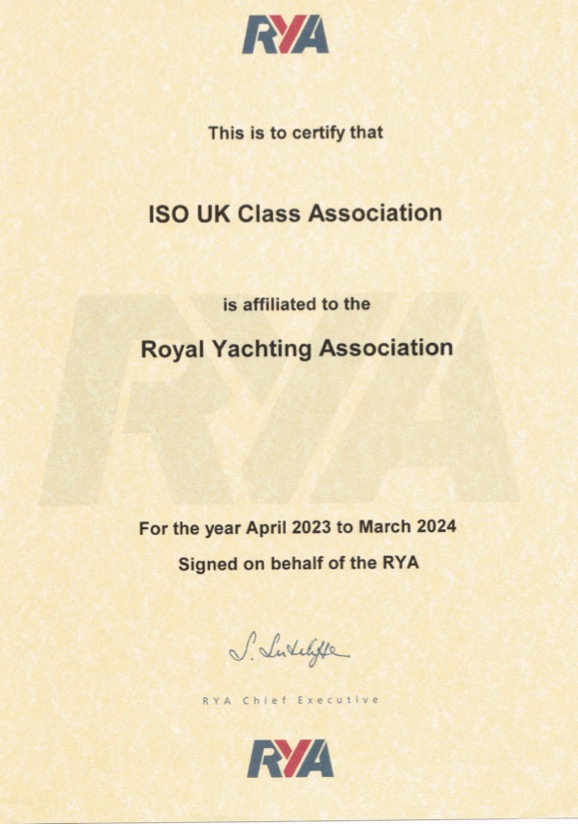ISO Training Weekend - Draycote Water SC (17th & 18th May 2003)
I am writing this report 12 days after the ISO Association training weekend at Draycote Water. I can now report I am no longer walking with a limp, I was able to manage stairs by the following weekend, and now it only hurts from my bruised ribs when I either sneeze or cough. You'll find out how I sustained these injuries further in the report. Would I do it again? You bet.
The boats arrived around 9.30 am Saturday morning, having all broken the one-way traffic system at the club by driving the wrong way round the dinghy park. After some initial confusion on where to rig the boats and some general mucking about - we picked our spot, keen to get masts up as instructed by 10am.
Twenty minutes later we made our first error having parked the boats in the parking space of the Sail and Surf shop owner. He was none too pleased and used one or two expletives to describe where we should rig our boats! Lyndon and Gareth, ISO 667, had left their gear on the path and the somewhat annoyed shop owner, whilst trying to negotiate his spot, drove his van over the amassed sailing gear only to then reverse off it, catching one of the guy's sailing bag under the front valance of his van dragging the bag across the dinghy park. Luckily no damage was done except to the reputation of the shop owner. An apology would have been nice however.
The assembled team was now 4 boats. Myself, Tony & John ISO 919, Lyndon and Gareth ISO 667, Becky and Julian ISO ??? and club resident Nigel and Sue ISO 808.
We spent a very constructive hour and a half going through rigging, tuning, ISO tweaks and sail set-up for different conditions. I personally took some comfort from the fact that like me, not everybody had done their ISO tweaks as "homework" as directed by Pete beforehand. Pete of course did point this out a number of occasions whilst going over the boats, but I argued that whilst the web-site does indeed have clear instructions, it was the theory that I was after. Frankly I don't think this argument did much to shift Pete's view other than to categorise us as a bunch of "lazy b*stards".
We completed the rigging, changed and met out on the water. We had our own space over the far side of the reservoir where Pete, Mandy and our rescue boat host, Chris from Draycote, who sails a Boss incidentally, laid a simple Windward / Leeward course and a starting gate. The plan was to do 5 short, back-to-back, 2-lap races concentrating on our starting techniques and boat handling.
The wind was a south-westerly force 3 - 4 and fairly gusty. The starting sequence was a simple 3-2-1 and once off, Pete followed the fleet, picking out a particular boat to cover with the video camera and to espouse some gentle words of encouragement.
Whilst all of us did sail up and down the start line to begin with, to look for line bias, having done this, our first mistake was that most of us then spent too much pre-start time too far away from the line. As the conditions were lively at the time, speaking personally, I think this was down to a boat-handling confidence factor. Overall the starts were between average to poor. When I mean poor, the worst case example was the lead boat taking some 25 seconds to cross the start line! However in our defence, there were times when Pete had left the rescue boat to join one of the crews to either helm or crew, we found later that he was the only rescue boat member to have a watch! On these occasions the starts, as one can imagine, were all over the place.
On the first race, Pete followed John and myself. The first criticism was I did not sail with the boat flat (and I mean dead flat), did not work the main hard enough and did not have enough kicker on. We did the course and after the finish Pete came aboard to look at our kicker. Whilst we were block-to-block, it was still not enough, so Pete re-tied it to gain more purchase. This advice is something that you cannot get off the web site. Even with the new amount of purchase, Pete's advice was to still have it set block-to-block for the upwind leg.
Pete spent a similar time with the other boats taking video footage and also taking on helming or crewing roles. For me this was very valuable as he took over the helm of my ISO, made John my crew really work for his living, and demonstrated how it should be sailed.
I cannot comment much on the other boats at this stage except we all capsized at some time or another, we probably did the most. Lyndon and Gareth had a bit of a disaster as the eye of the mainsail clew pulled out thus having to retire early.
We came ashore after the first afternoon having learnt so much about boat set-up, the real purpose for the ISO tweaks and boat handling.
We arrived on Sunday morning for around 9.30. This was a fair challenge in itself but the wind and showers guaranteed my hangover wouldn't last too long. After a quick chat we launched and found this time we were given the north-east corner of the reservoir to play with, well away from the club sailing. All 4 boats were back out with Lynden and Gareth on a borrowed mainsail. This proved to be the windiest part of the reservoir as the wind was now South-Westerly 4. Getting everyone to the start line was proving to be challenging in its own right. After some considerable delay, during which Julian got cracked on the head by the boom so badly that he momentarily blacked out having to retire, we managed only one race of one lap. The most notable experience for me during the race and after we hoisted on the down wind leg and got settled down, the boat suddenly accelerated with such force both of us were pushed back as if we'd been driven by a boy racer! Even better was the fact that we hung on to it and even completed the gybe without swimming. After the race Pete asked us to hold on as the other boats sailed back to the club. This gave us some good sailing, but instruction was later sent for us to come in also.
Sailing back to the club on a beat was most exhilarating. It took us about 40 minutes, much of the time I was buried in spray and very grateful for John calling the gusts. Its in these conditions that contact lenses are bloody useless. Much of the time is spent with either one eye or both fogged up, thus adding a new dimension to the sailing. We managed to get ashore, I can't remember how many capsizes we had however. The general chat & debrief was most amusing with everyone having one story after another about various accidents, capsizes or general prangs. Lynden and Gareth had again had to retire, this time with a mangled gooseneck fitting on the boom.
Because the sailing club was in the lee of a hill to the south-westerly wind, the conditions did not look as bad as they were. We were tempted to go back out with just a couple of boats after a very brief lunch. At this point we soon realised that the wind had not abated. I foolishly called for the spinnaker only to realise after it set that we were on the wrong course and had to gybe! Of course we didn't make it. Becky and Julian were similarly challenged, with Becky falling off the helm whilst Julian was still trapezing.
After bit of a difficult righting, we eventually go the boat back up, practicing my San Francisco rolls in the process (and later picking up more tips from Pete on these). Things were pretty tangled when we climbed back in, only to realise that at least for ourselves, we were in survival conditions.
We decided to abandon all attempts to race, as it turned out a unanimous decision and we decided to head back to safety. At this point John, my 14st crew, got knocked sideways off the trapeze due to the sheer volume of water/spray, took me out as well, then landed on top of me on his second swing pinning me against the mast and boom. I'd thought I'd broken my leg - I certainly bruised my ribs. After the capsize we just sat on the upturned hull for 10 minutes glad of the rest. John sustained similar injuries and at this point, we did wonder what the hell we were doing and perhaps the ISO should be for younger chaps not at their mid-life crisis stage. We quickly sobered up and picked the boat up again. On a subsequent capsize, whilst trying to make it back to the club house, John again flew off the trapeze as the boat capsized to leeward, unhooking the trapeze wire from the hounds on the mast, only to go flying through my mainsail! Talk about a novel way to de-power the sail. So back to the menders again!!!!
In concluding, we had an excellent weekend, even though it took us about two hours to pack the boat away as it was so painful to bend down. We learnt hell of a lot and feel a lot more confident on the water. I would like to thank Pete Lindley, camera woman Mandy Hindle, Boat drivers Chris & Alan Gandy, for giving up their weekend to encourage the newcomers, when they could be sailing instead.
We also very much enjoyed meeting the other ISO'ers and look forward to their company again.
My sailing tips summary:
There were several things we learnt during the weekend and during the video play-backs. Personally for me they were;
- Stand up in the boat more often to gain confidence and to help with the balance, particularly when tacking, gybing and rounding marks.
- Keep the boat dead flat at all times, particularly when going in to tacks and gybes.
- Use minimal rudder movements and slow turns when tacking and gybing.
- When bearing away at a windward mark, have the boat dead flat or slightly to windward, leave the crew to decide when to come in off the wire, move the weight aft and let out lots of sail on the turn. If the boat is heeling to leeward, it will resist all attempts to bear away, thus opening up the gap between you and the windward mark to allow a competitor to sail below you and lose your advantage.
- When gybing, go for maximum speed to take the pressure off the rig, start to haul in the main, stand up, move the tiller slowly and at the same time grab the mainsheet bunch to bring over the sail. This I kept getting wrong, and spent most of the time in the water and having picked up one monumental crack on the head from the boom.
- There were a number of very good crewing tips we picked up as well. Of course as a helm, I knew them all along, but it helped to get it reinforced by Pete anyway:
- Stand up in the boat more rather than grovelling around on your knees, particularly during tacks and gybes.
- Keep good house keeping, keep checking for knots and ties in the sheets.
- Stand up when launching the spinnaker to get big arm fulls and reduce the chance of kneeling on the sheets.
- Let the helm pull out the pole.
- Get the helm take the windward spinnaker sheet whilst launching, similarly get the helm take the leeward spinnaker sheet when dousing, to keep the spinnaker going for few more seconds.
- Whilst trapezing keep the feet together, front foot pointing forward, hold the jib sheet with the aft hand, lower the forward shoulder so that the crew is looking forward and able to call the gusts and other words of encouragement.
- Oh and take off that silly jib roller reefing mechanism.
Excellent weekend, loads learnt, more confidence gained. See you next time!





